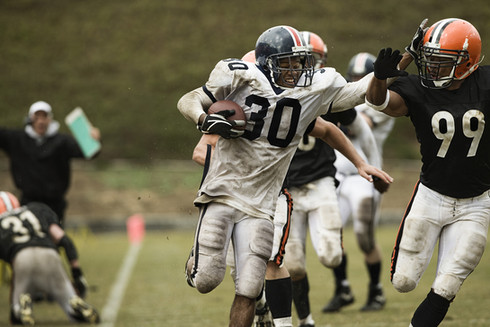The Path to Faster Performance: Understanding the Time Investment in Speed Training
- Nathan Albright
- Oct 28, 2024
- 6 min read
Updated: Oct 29, 2024

Speed is one of the most sought-after attributes in team sports, whether it’s sprinting down the soccer field, breaking away down the court in basketball, or accelerating to make the play in football. For young athletes, developing speed is critical for athletic success, but it’s also one of the most challenging physical qualities to improve. Speed development is a long-term process that requires patience, consistent effort, and a deep understanding of the physiological and biomechanical factors involved. This journey can span several years, from youth sports into high school and beyond.
Neuromuscular Development: The Foundation of Speed
Speed is heavily reliant on the neuromuscular system, which governs how efficiently the brain communicates with the muscles. For youth athletes, this communication is often not fully developed. Early on, they may have the raw energy and excitement for movement, but they lack the refined motor skills and coordination needed to move quickly and efficiently.
Fast-twitch muscle fibers (Type II fibers) are responsible for explosive movements like sprinting. These fibers generate more force than slow-twitch fibers but fatigue faster. Training these fibers requires consistent high-intensity efforts, such as sprint drills and strength exercises, as well as isometric holds which teach the nervous system to recruit more motor units and activate them more efficiently. As athletes move from youth sports into high school, their ability to recruit fast-twitch fibers improves, allowing them to run faster and respond quicker in game situations. However, these adaptations don’t happen overnight. It can take months—sometimes years—of targeted training to build the neuromuscular foundation necessary for optimal speed.
Strength and Power: Building Explosive Athletes
In the early stages of athletic development, many youth athletes lack the overall strength required to move explosively. This is why strength training becomes increasingly important as they progress through their athletic journey. The more force an athlete can generate in a short period, the faster they will be able to move. For young athletes, increasing relative strength (strength per unit of body weight) is key. This can be achieved through exercises like squats, lunges, and push-ups, which not only build muscle but also teach athletes how to control their bodies. As they enter high school, athletes often begin incorporating more advanced strength training, such as lifting weights, to develop the rate of force development (RFD)—the ability to apply force rapidly. RFD is critical for sprinting because it determines how quickly an athlete can push off the ground and accelerate. But strength alone isn’t enough; athletes need to translate that strength into explosive power. This is where exercises like plyometrics and sprint training come into play. These activities train the stretch-shortening cycle (SSC), which allows muscles to store elastic energy during a quick stretch (eccentric phase) and release it explosively during the shortening (concentric phase). Developing an efficient SSC is essential for reducing ground contact time during sprints, a key factor in speed. However, tendons and muscles adapt to this type of training slowly, which is why plyometrics are progressively introduced as athletes mature.
Diving Deeper into Building Explosive Athletes
Yuri Verkhoshansky was a Soviet sports scientist and coach renowned for his pioneering work in plyometrics and explosive power training. Known as the "Father of Plyometrics," Verkhoshansky developed training methods focused on enhancing an athlete's ability to generate force rapidly, which has had a profound influence on sports conditioning worldwide. His work has particularly impacted power, speed, and agility training for athletes in high-speed and high-power sports. The Shock Method, one of Verkhoshansky's most famous contributions, involves using depth jumps to improve an athlete's reactive strength and rate of force development (RFD). In this method, an athlete steps off a platform, lands to create a rapid eccentric (stretch) contraction in the muscles, and then immediately performs a powerful jump upward or forward. This rapid transition from landing to jumping, known as the stretch-shortening cycle (SSC), trains muscles and tendons to store and release elastic energy more effectively, resulting in improved explosiveness and speed in athletic movements.

Source: https://www.verkhoshansky.com/Technical Mastery: Running Efficiently
One of the major reasons speed development takes time is that running fast isn’t just about effort; it’s about efficiency. Many young athletes waste energy via compensations in their running form. Over-striding, swinging the arms inefficiently, or having poor posture can all limit an athlete’s top speed. As youth athletes grow, they must work towards refining their sprint mechanics. High school athletes often begin to work on improving their stride length and stride frequency—the two main components of speed. Stride length refers to how far an athlete travels with each step, while stride frequency refers to how quickly they take those steps. Optimizing both simultaneously requires precise coordination of muscle contractions and movements. Athletes must also work on reducing their ground contact time (GCT), the amount of time their feet spend on the ground during each stride. Elite athletes are able to minimize GCT by maximizing the stiffness of their tendons and the force they apply to the ground. Developing this skill takes years of practice and attention to biomechanical details.
Energy System Development: Fueling Speed
Speed in team sports, particularly in sprint-heavy actions like chasing down a ball or breaking away from defenders, relies on the body's anaerobic and aerobic energy systems. Short, high-intensity efforts lasting less than 10 seconds are powered by the ATP-PCr system, which provides energy for quick bursts of speed. Young athletes typically have limited capacity in these energy systems and need to train their bodies to efficiently regenerate ATP (adenosine triphosphate) and phosphocreatine, the main fuels for these sprints. As athletes mature into high school and beyond, their ability to tolerate and recover from intense anaerobic efforts improves. Aerobic conditioning, often associated with endurance, plays a critical role in supporting speed for athletes through several key mechanisms. First, it enhances recovery between sprints by improving the body’s ability to clear lactate and replenish ATP, which allows for repeated high-intensity efforts over a game or training session. Aerobic training also increases mitochondrial density and efficiency, boosting the muscle cells' ability to recycle energy. This energy efficiency helps athletes sustain high-intensity efforts for longer, making it easier to maintain speed even in the later stages of games or sessions. Moreover, aerobic conditioning strengthens the heart and enhances circulation, ensuring better oxygen and nutrient supply to muscles during intense exercise. This improved blood flow aids in quicker recovery from the muscular stress of sprinting, allowing athletes to train frequently and perform at high levels. Additionally, aerobic conditioning supports muscular endurance, helping athletes maintain form and power over multiple sprints, and enhances fatigue resistance, delaying the onset of muscle fatigue. Together, these benefits establish a physiological foundation for quick recovery, fatigue resistance, and consistent sprint mechanics, all of which contribute to sustaining high-level speed throughout training and competition.
Need a refresher on energy systems? Read: How Do Energy Systems Impact Athletic Performance https://www.xisportsperformance.com/post/how-do-energy-systems-impact-athletic-performance
Tendon and Muscle Adaptations: Elasticity and Stiffness
In addition to muscles, tendons play a crucial role in speed development. The stiffer an athlete’s tendons, the better they can store and release elastic energy during fast movements, such as sprinting. Stiff tendons act like springs, propelling athletes forward with minimal energy loss. However, tendon adaptations occur more slowly than muscle adaptations, often taking years of plyometric and strength training to develop fully. For young athletes, learning to generate and transfer force effectively through the muscle-tendon unit is a gradual process. Using exercises such as isometrics, plyometrics, and other forms of training will continue progress into high school, these exercises become more advanced, leading to improved load tolerance that can aid in improved sprint mechanics and speed.
Biomechanical Efficiency: Learning to Apply Force
One of the more advanced aspects of speed development is teaching athletes to apply force in the most efficient direction. In the acceleration phase of sprinting, athletes need to apply force more horizontally to drive themselves forward. Many young athletes naturally apply force vertically (upward), which limits their ability to accelerate quickly. Into high school years, athletes begin learning how to optimize their force vectors, or the direction in which force is applied. This requires specific sprint drills and strength training exercises that mimic the demands of acceleration in sport. Over time, athletes learn to reduce wasted motion and maximize their ability to accelerate off the line, a critical skill in team sports like football, soccer, and basketball.
Conclusion: Patience and Long-Term Development
For team sport athletes, developing speed is a long-term investment that spans years of training. While youth athletes may begin with raw potential, the path to elite speed involves refining neuromuscular coordination, building strength and power, optimizing biomechanics, and developing energy systems. It’s important for young athletes, coaches, and parents to understand that speed isn’t developed overnight. From youth sports through high school and beyond, each phase of training builds on the previous one, and the gradual adaptations in strength, technique, and energy systems pay off over time. Consistent, focused training, combined with patience and proper recovery, are key to unlocking an athlete’s full speed potential.

About the Author:
Nathan Albright is the owner of XI Sports Performance, where he works with youth, high school, and college-level athletes offering a wide variety of training with various sports, including Soccer, Football, Basketball, Baseball, Volleyball, and more. Nathan has a BSc. in Exercise Kinesiology from the University of Toledo, and currently resides in Northwest Ohio.














Comments